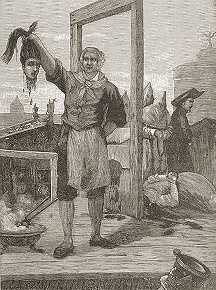Giovanni Battista Bugatti
| Mastro Titta | |
|---|---|
 Mastro Titta offering snuff to a condemned prisoner before carrying out an execution. From a 19th Century woodcut. | |
| Born |
6 March 1779 Senigallia, Ancona, Marche, Italy |
| Died |
18 June 1869 (aged 90) Senigallia, Ancona, Marche, Italy |
| Title | Official Executioner for the Papal States |
| Term |
22 March 1796 – 17 August 1861 (65 years, 148 days) |

Giovanni Battista Bugatti (1779–1869) was the official executioner for the Papal States from 1796 to 1865. He was the longest-serving executioner in the States and was nicknamed Mastro Titta, a Roman corruption of maestro di giustizia, or master of justice.[1] At the age of 85, he was retired by Pope Pius IX with a monthly pension of 30 scudi.
Biography
He referred to his executions as justices and the condemned as patients. His first execution was on March 22, 1796. Up until 1810, the method of execution was beheading by axe, hanging or mallet. The French introduced the use of the guillotine which was continued after the Papal States regained their sovereignty (first beheading by guillotine under papal reign: 1816) until the last executions. He carried out a total of 516 executions.
Bugatti is described as being short and portly, and always well dressed. He frequented the church Santa Maria in Traspontina. He was married but had no children. When not carrying out his official duties, Bugatti and his wife sold painted umbrellas and other souvenirs to tourists.
He could not leave the Trastevere neighborhood unless on official business. Officially this was for his own protection, in case relatives of those he had executed decided to take revenge against him. Unofficially it was probably due to superstition regarding his part-time job. On his crossing the bridge, the residents of Rome were alerted that an execution was about to take place and people would gather to witness the popular event.
One of his executions, carried out on 8 March 1845 was described by Charles Dickens in his work Pictures from Italy (1846).
His blood-stained clothes, axes and guillotines are on display at the Museum of Criminology at Via del Gonfalone. The guillotine is of a very peculiar build, with straight blade and V-shaped neckpiece.
See also
- List of people executed by the Holy See
Notes
- ↑ Allen, John L., Jr. 2001, September 14. "He executed justice – papal execution Giovanni Battista Bugatti's life and work". National Catholic Reporter.
References
- He executed justice. Retrieved 11 April 2005
- Mastro Titta. Retrieved 14 July 2005.
- Passage from Pictures From Italy. Retrieved 14 July 2005.
- When Mastro Titta Crossed the Bridge
External links
- Mastro Titta, page on Bugatti, Website of Museo Criminologico, Rome
- Papal guillotine, Website of Museo Criminologico, Rome
- (Italian) Mastro Titta, il boia di Roma: Memorie di un carnefice scritte da lui stesso
|